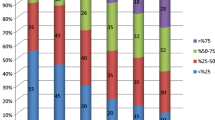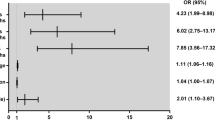Abstract
Background
The results of vagus nerve stimulation (VNS) for the treatment of drug-resistant epilepsies are highly variable due to the lack of defined patient’s selection criteria and a follow-up of published studies being generally too short. Here we report the outcome of VNS in a series with long-term follow-up and try to identify subgroups of patients who could be better candidates for this procedure.
Method
We studied 53 patients (33 male, 20 female) with a prospectively recorded follow-up (mean, 55.96 ± 43.53 months). The monthly average seizure frequency for each patient at baseline, 3, 6, 12 months, and each year until the latest follow-up after implant was measured and the percentage of “responders” and response time (RT) were calculated. We investigated the following potential prognostic role of these factors: age of onset of epilepsy, pre-implant epilepsy duration, etiology, and age at implant.
Results
Globally, 40 % of patients responded to VNS (mean RT, 14.85 ± 16.85 months). Lesional etiology (p = 0.0179, logrank test), particularly ischemia (p = 0.011, Fisher exact test) and tuberous sclerosis (p = 0.0229, Fisher exact test), and age at implant <18 years (p = 0.0242, logrank test) were associated to better response to VNS. In the lesional subgroup the best results were observed in patients with a pre-implant epilepsy duration <15 years (p = 0.0204, logrank test) and an age at implant <18 years (p = 0.0187 logrank test).
Conclusions
The best candidate to VNS seems to be a patient with lesional etiology epilepsy (particularly post-ischemic and tuberous sclerosis) and a short duration of epilepsy who undergo VNS younger than 18 years.

Similar content being viewed by others

References
Casazza M, Avanzini G, Ferroli P, Villani F, Broggi G (2006) Vagal nerve stimulation: relationship between outcome and electroclinical seizure pattern. Seizure 15:198–207
Colicchio G, Policicchio D, Barbati G, Cesaroni E, Fuggetta F, Meglio M, Papacci F, Rychlicki F, Scerrati M, Zamponi N (2010) Vagal nerve stimulation for drug-resistant epilepsies in different age, aetiology and duration. Childs Nerv Syst 26:811–819
Englot DJ, Chang EF, Auguste KI (2011) Vagus nerve stimulation for epilepsy: a meta-analysis of efficacy and predictors of response. J Neurosurg 115:1248–1255
Frost M, Gates J, Helmers SL, Whelles JW, Levsohn P, Tardo C, Conry JA (2001) Vagus nerve stimulation in children with refractory seizures associated with Lennox-Gastaut syndrome. Epilepsia 42:1148–1152
Labar D (2004) Vagus nerve stimulation for 1 year in 269 patients on unchanged antiepileptic drugs. Seizure 13:392–398
Labar D, Murphy J, Tecoma E (1999) Vagus nerve stimulation for medication-resistant generalized epilepsy. E04 VNS Study Group. Neurology 52:1510–1512
No authors listed (1995) A randomized controlled trial of chronic vagus nerve stimulation for treatment of medically intractable seizures. The Vagus Nerve Stimulation Study Group. Neurology 45:224–230
Parker APJ, Polkey CE, Binnie CD, Madigan C, Ferrie CD, Robinson RO (1999) Vagal nerve stimulation in epileptic encephalopathies. Pediatrics 103:778–782
Rychlicki F, Zamponi N, Trignani R, Ricciuti RA, Iacoangeli M, Scerrati M (2006) Vagus nerve stimulation: clinical experience in drug-resistant pediatric epileptic patients. Seizure 15:483–490
Conflicts of interest
None.
Author information
Authors and Affiliations
Corresponding author
Rights and permissions
About this article
Cite this article
Colicchio, G., Montano, N., Fuggetta, F. et al. Vagus nerve stimulation in drug-resistant epilepsies. Analysis of potential prognostic factors in a cohort of patients with long-term follow-up. Acta Neurochir 154, 2237–2240 (2012). https://doi.org/10.1007/s00701-012-1524-9
Received:
Accepted:
Published:
Issue Date:
DOI: https://doi.org/10.1007/s00701-012-1524-9



